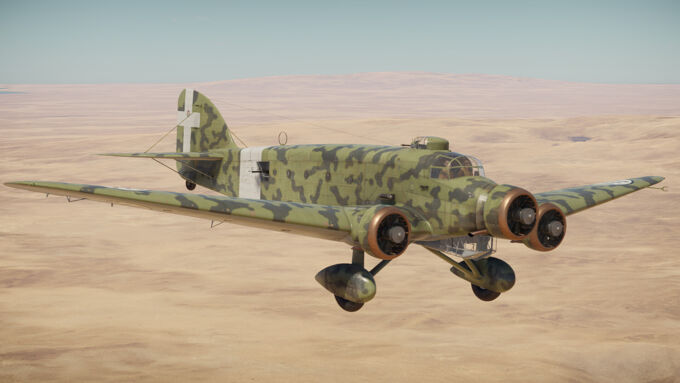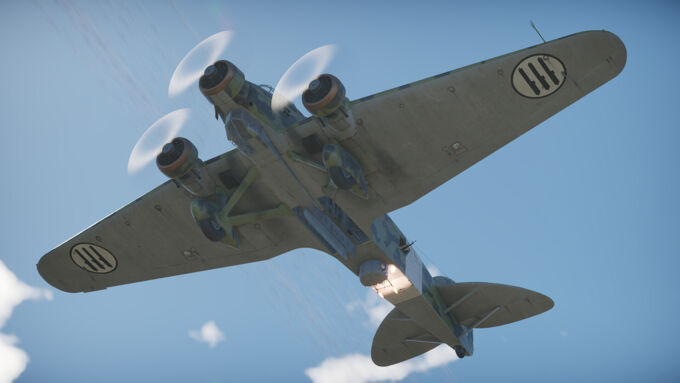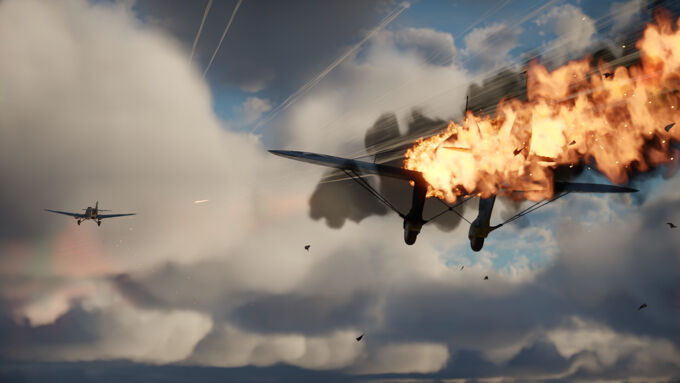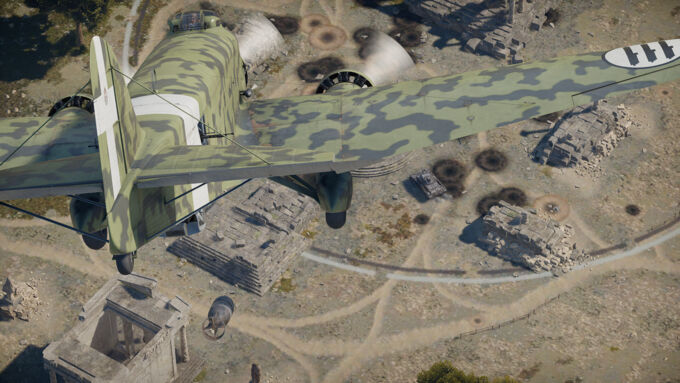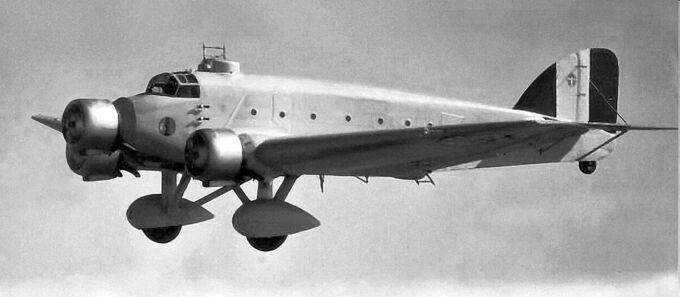The Savoia-Marchetti SM.81 Pipistrello was the first three-engined bomber/transport aircraft serving in the Regia Aeronautica (Royal Italian Air Force). When it appeared in 1935, it represented a real step ahead in Italian military aviation as it was fast, well armed and had a long range. In War Thunder, this airplane is featured as an early bomber available in the Italian aviation tech tree which, albeit not the fastest or well protected, is quite powerful if used correctly, mainly thanks to its payloads, which are quite impressive for a frontline bomber at its rank.
| Pros | Cons |
| Has self-sealing fuel tanks. | Defensive armament consists of low-calibre machine guns. |
| Fixed landing gear allows easy landings. | No armour protection. |
| Good payload options. | Is large, making it an easy target for fighters and SPAA. |
| Defensive armament has good coverage. | Maximum speed, although reasonable, is relatively low when compared to other early bombers. |
Survivability:
The S.81 does not feature any armour protection at all, meaning that even low-calibre machine guns can pose a threat to it. Morevoer, this bomber features three radial engines which can be very easily destroyed if the pilot is not careful. It is advised to avoid exposing your cockpit and engines to the enemy, as these are the bomber’s weak spots. Fortunately, the fuel tanks are self-sealing, which gives the S.81 a higher probability of putting out fires.
Flight Performance:
With a maximum speed of only 335 km/h, the Pipistrello is rather slow, even for an early bomber. Most of its contemporaries, like the SB 2M-100 or the Blenheim Mk IV, for example, have maximum speeds of 400 km/h or more. This is mostly due to the fact that the Pipistrello has a fixed landing gear, which causes drag. Rate of climb and roll rate are quite poor as well, but, surprisingly, it has a relatively decent turn time. Deploying combat flaps will allow you to turn faster.
Unfortunately for bombers, speed is a vital asset and even some biplanes can catch up with the S.81. Staying away from enemy aircraft is recommended, but if needed, your defensive armament is good enough to deal with the fragile enemies that this bomber encounters.
Armament:
Suspended Armament:
The S.81 has access to four setups:
| Setup 1 | 28 × 50 kg GP 50 bombs |
| Setup 2 | 16 × 100 kg GP 100T bombs |
| Setup 3 | 4 × 250 kg GP 250 bombs |
| Setup 4 | 4 × 500 kg GP 500 bombs |
The 50 kg bombs are rather worthless since they have little explosive mass, but when you unlock this bomber, you will have to rely on them at first. The most useful bombs are the 250 kg and 500 kg bombs, with which you can attack ground targets and bomb bases effectively (although the 500 kg bombs work even better). You can destroy two bases with the 500 kg bombs by dropping two bombs per base, making them the most effective.
Defensive Armament:
The S.81's defensive armament consists of two turrets located in the plane’s fuselage, each equipped with one 7.7 mm Lewis machine gun, as well as one turret below the fuselage and another behind the cockpit, each with two 7.7 mm Breda-SAFAT machine guns. The armament itself is rather poor due to the low calibre of the machine guns. However, most enemies that the S.81 faces are poorly armoured and can be easily destroyed. Furthermore, the turrets, mainly the one located behind the cockpit, have good coverage, leaving the S.81 with relatively few blind spots.
Usage In Battles:
Air Battles:
In air battles, the S.81 is better used for base bombing. As mentioned above, the 500 kg bombs are the most useful since you can destroy two bases with them by dropping two bombs per base. Attacking ground targets can also be done. For this type of mission, using the 100 kg bombs is the better choice because you get sixteen of them and they have enough explosive mass to destroy both unarmoured and armoured targets reliably.
Being a bomber, you are an appetizing target for fighter aircraft. Even though you mostly face slow biplanes and early monoplanes, they can still be dangerous due to the fact that, as mentioned above, the S.81 has no armour protection. Fortunately, most of your enemies also lack or have very little armour. If you are being chased by an enemy fighter, use your defensive turrets to shoot them down or scare them away. Remember not to expose your cockpit or engines because they are your weak spots.
Mixed Battles:
In mixed battles, the Pipistrello can be used for close air support, although it won’t be as easy as performing the same task while piloting a single-engined airplane. Due to its size, the Pipistrello can be an easy target for SPAA and enemy aircraft. It is recommended to only use the S.81 when enemy aviation is not present or very little. It is also important to stay away from enemy self-propelled anti-aircraft guns.
For close air support, it is recommended to use either the 250 kg bombs or the 500 kg bombs, with the latter being more effective. Using the bomb sight, drop the bombs where there are enemy vehicles. It should be noted that, due to your size and lack of agility, it is better to hit stationary enemies or capture points once you’re notified of enemy presence in them. It is advised not to fly over the battlefield for long as the enemy will soon spawn SPAAs or aircraft to intercept you. Find enemies, drop your bombs (one per tank is enough) and go back to the airfield to rearm.
The Vehicle’s History:
Design And Development:
The SM.81 started out as a militarised version of the SM.73 airliner. It was a rugged three-engine monoplane with a fixed tailwheel and large spats covering the main wheels. The prototype, designated MM.20099, took its first flight on February 8, 1934, from Vergiate, with Adriano Bacula at the controls. By 1935, an order for 100 units was placed, with the first batch going to 7 Wing at Campo della Promessa airbase near Lonate Pozzolo.
The SM.81 had a steel-tube fuselage combined with wood and fabric, making it unusually large for a bomber, which later made it well-suited as a transport aircraft. Its three engines gave it a somewhat awkward appearance, and the numerous windows made it look more like a passenger plane than a military aircraft. It featured all-wood wings, a fabric-covered metal tail, and an enclosed cockpit for the pilot and co-pilot. The bombardier had a retractable gondola beneath the cockpit, offering a clear view for targeting. Just behind the cockpit was the bomb bay, which connected to defensive positions within the fuselage.
Though well-armed, drag from its design limited speed and range. However, its strong build made it reliable, easy to fly, and capable of operating on various terrains. It lacked armor, except for self-sealing fuel tanks.
Propulsion:
The SM.81 used various engines, including Alfa Romeo, Gnome-Rhône, and Piaggio radials, producing between 580 and 1,000 hp. One SM.81bis prototype had two Isotta-Fraschini inline engines but was not developed further.
Production numbers of SM.81s built with each engine:
- Alfa Romeo 125 RC.35, 432–507 kW (580–680 hp) — 192 SM.81s built.
- Gnome-Rhône 14K, 485–746 kW (650–1,000 hp) — 96 SM.81s built.
- Piaggio P.X R.C.15, 501–522 kW (670–700 hp) — 48 SM.81s built.
- Piaggio P.IX R.C.40, 507 kW (680 hp) — 140 SM.81s built.
- Alfa Romeo 126 RC.34, 582–671 kW (780–900 hp), also fitted to early versions of the SM.79 — 58 SM.81s built.
Initially, the SM.81 performed well, reaching over 200 mph with a 23,000-ft ceiling and a 1,200-mile range. However, by World War II, these specifications were outdated, making it highly vulnerable to modern fighters.
Operational History:
The SM.81 first saw action in the Second Italo-Abyssinian War, where it proved to be a versatile bomber, transport, and reconnaissance aircraft. It later took part in the Spanish Civil War, serving with the Aviazione Legionaria and being among the first aircraft sent by the fascist powers to support the Nationalist faction.
By the start of World War II, around 300 SM.81s were still in service with the Regia Aeronautica, but they were already outdated, being slower than modern bombers and easy targets for enemy fighters. Production had ended in 1938, and the more advanced SM.79 had taken over its role. As a result, the SM.81 was relegated to secondary duties, mainly serving as a transport during the day and as a night bomber, particularly in North Africa. Most were phased out by the time of the Italian armistice in 1943, though some continued to fly with both the Italian Social Republic and the Italian Co-Belligerent Air Force. A handful even survived the war and remained in service with the Aeronautica Militare Italiana, but by 1950, they had all been retired.
Two versions of this airplane existed: the SM.81 bomber/transport and the SM.81/T transport. An experimental twin-engine variant was tested but ultimately scrapped due to poor performance. Beyond Italy, the SM.81 also saw service with the Republic of China and Spain, though China’s three aircraft were lost in training accidents by early 1938.
Sources:
- https://en.wikipedia.org/wiki/Savoia-Marchetti_SM.81_Pipistrello
- https://en.wikipedia.org/wiki/Operational_history_of_the_Savoia-Marchetti_SM.81
- https://www.gruppofalchi.com/files/Profile-Publications-Aircraft-146---Savoia-Marchetti-SM-81.pdf
- https://www.militaryfactory.com/aircraft/detail.php?aircraft_id=811
